MBA Strategic Management: Air Asia's Analysis and Implementation
VerifiedAdded on 2023/06/04
|20
|4293
|219
Report
AI Summary
This report provides a comprehensive strategic analysis of Air Asia, a Malaysian multinational airline. It begins with an overview of the company's history, vision, and mission, highlighting its focus on low-cost fares and extensive route network. The report then delves into Air Asia's strategic development decisions, emphasizing its initial expansion strategy and subsequent focus on cost leadership, innovation, and sustainability. A PEST analysis examines the political, economic, social, and technological factors influencing the Malaysian aviation industry. Porter's Five Forces framework is used to assess the competitive intensity, bargaining power of customers and suppliers, and the threat of substitutes. The analysis concludes that Air Asia must maintain a competitive advantage through strategies such as cost leadership and differentiation. The report also discusses strategies for defending its core business and the resource implications of these strategies. The report concludes by summarizing the key findings and offering recommendations for Air Asia's future strategic direction. Desklib provides a platform for students to access similar past papers and solved assignments.
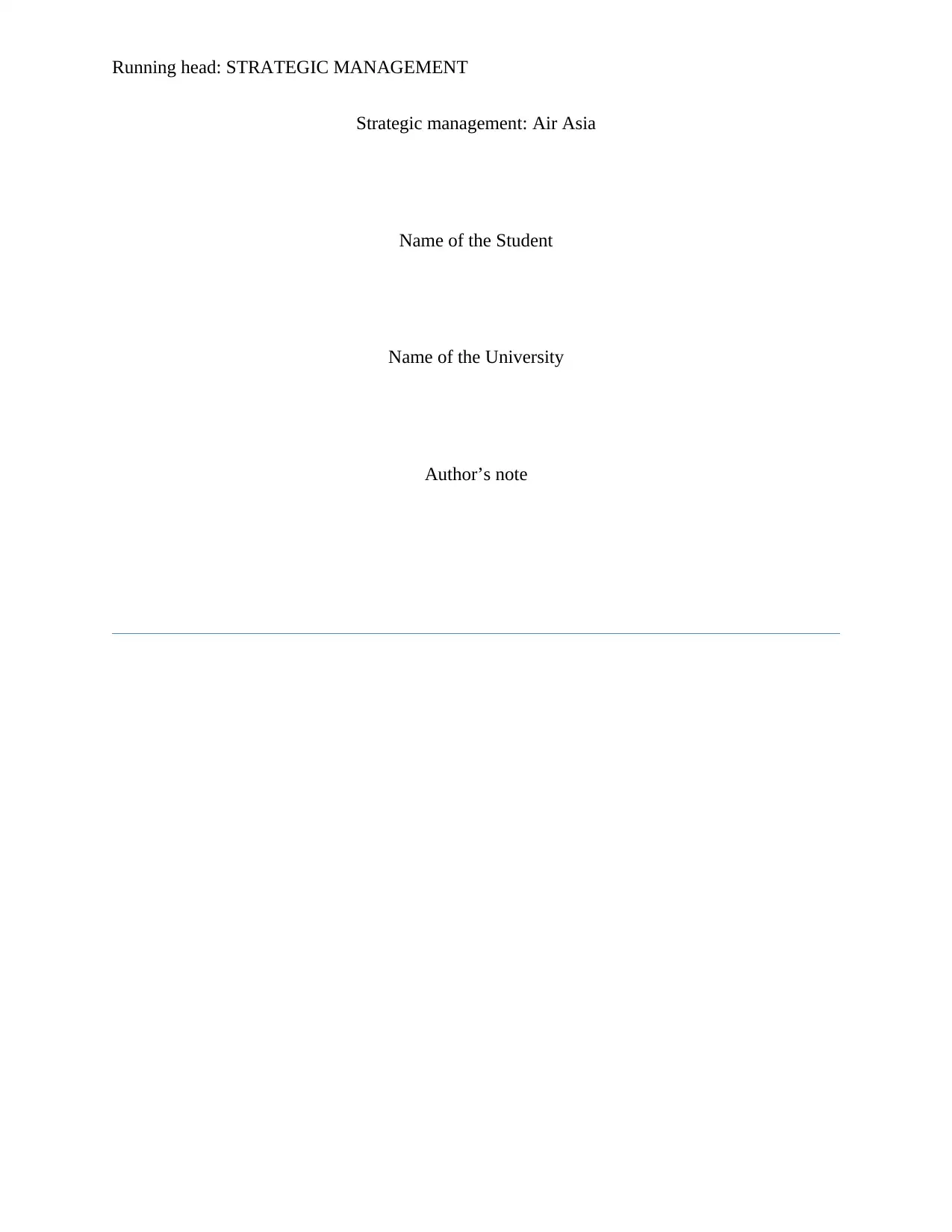
Running head: STRATEGIC MANAGEMENT
Strategic management: Air Asia
Name of the Student
Name of the University
Author’s note
Strategic management: Air Asia
Name of the Student
Name of the University
Author’s note
Paraphrase This Document
Need a fresh take? Get an instant paraphrase of this document with our AI Paraphraser
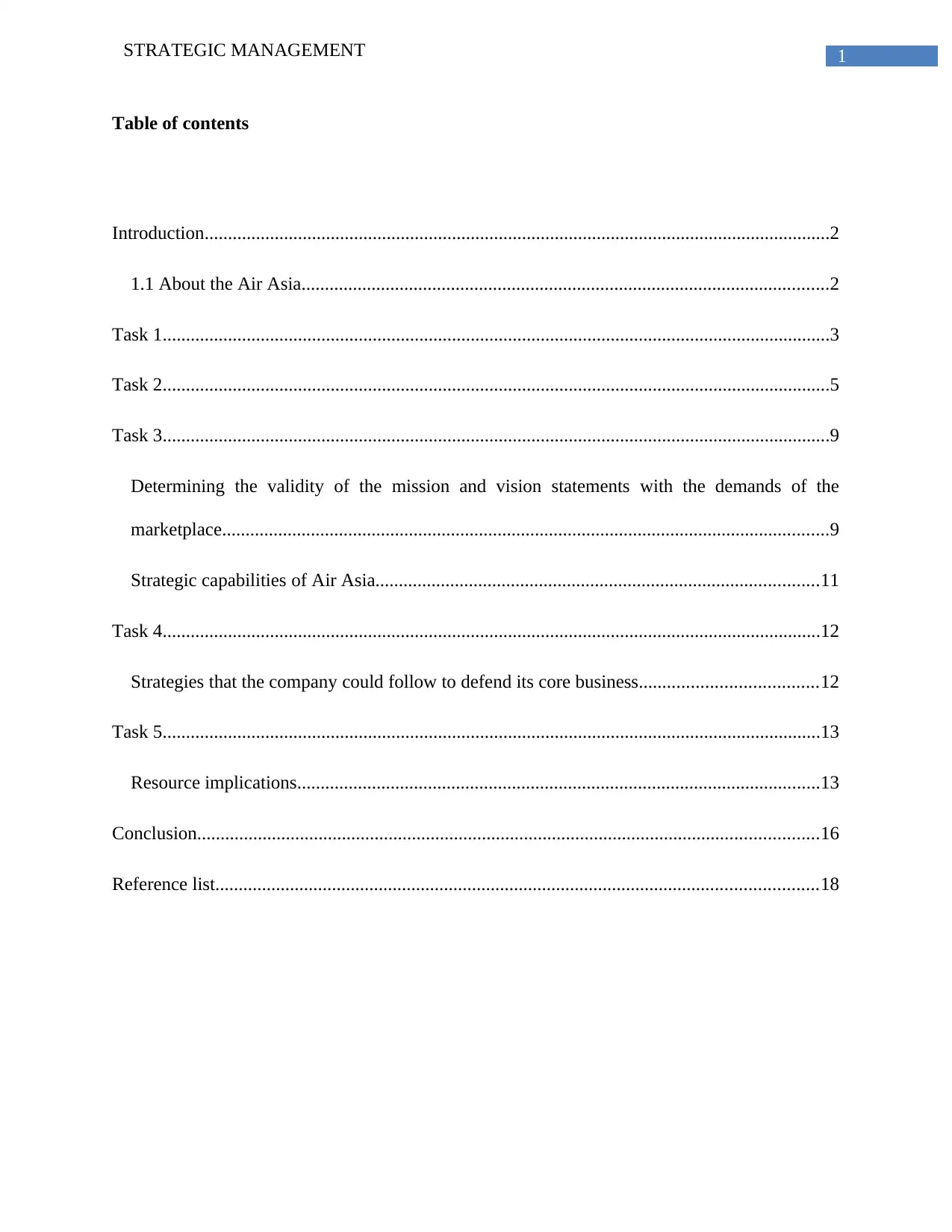
1STRATEGIC MANAGEMENT
Table of contents
Introduction......................................................................................................................................2
1.1 About the Air Asia.................................................................................................................2
Task 1...............................................................................................................................................3
Task 2...............................................................................................................................................5
Task 3...............................................................................................................................................9
Determining the validity of the mission and vision statements with the demands of the
marketplace..................................................................................................................................9
Strategic capabilities of Air Asia...............................................................................................11
Task 4.............................................................................................................................................12
Strategies that the company could follow to defend its core business......................................12
Task 5.............................................................................................................................................13
Resource implications................................................................................................................13
Conclusion.....................................................................................................................................16
Reference list.................................................................................................................................18
Table of contents
Introduction......................................................................................................................................2
1.1 About the Air Asia.................................................................................................................2
Task 1...............................................................................................................................................3
Task 2...............................................................................................................................................5
Task 3...............................................................................................................................................9
Determining the validity of the mission and vision statements with the demands of the
marketplace..................................................................................................................................9
Strategic capabilities of Air Asia...............................................................................................11
Task 4.............................................................................................................................................12
Strategies that the company could follow to defend its core business......................................12
Task 5.............................................................................................................................................13
Resource implications................................................................................................................13
Conclusion.....................................................................................................................................16
Reference list.................................................................................................................................18
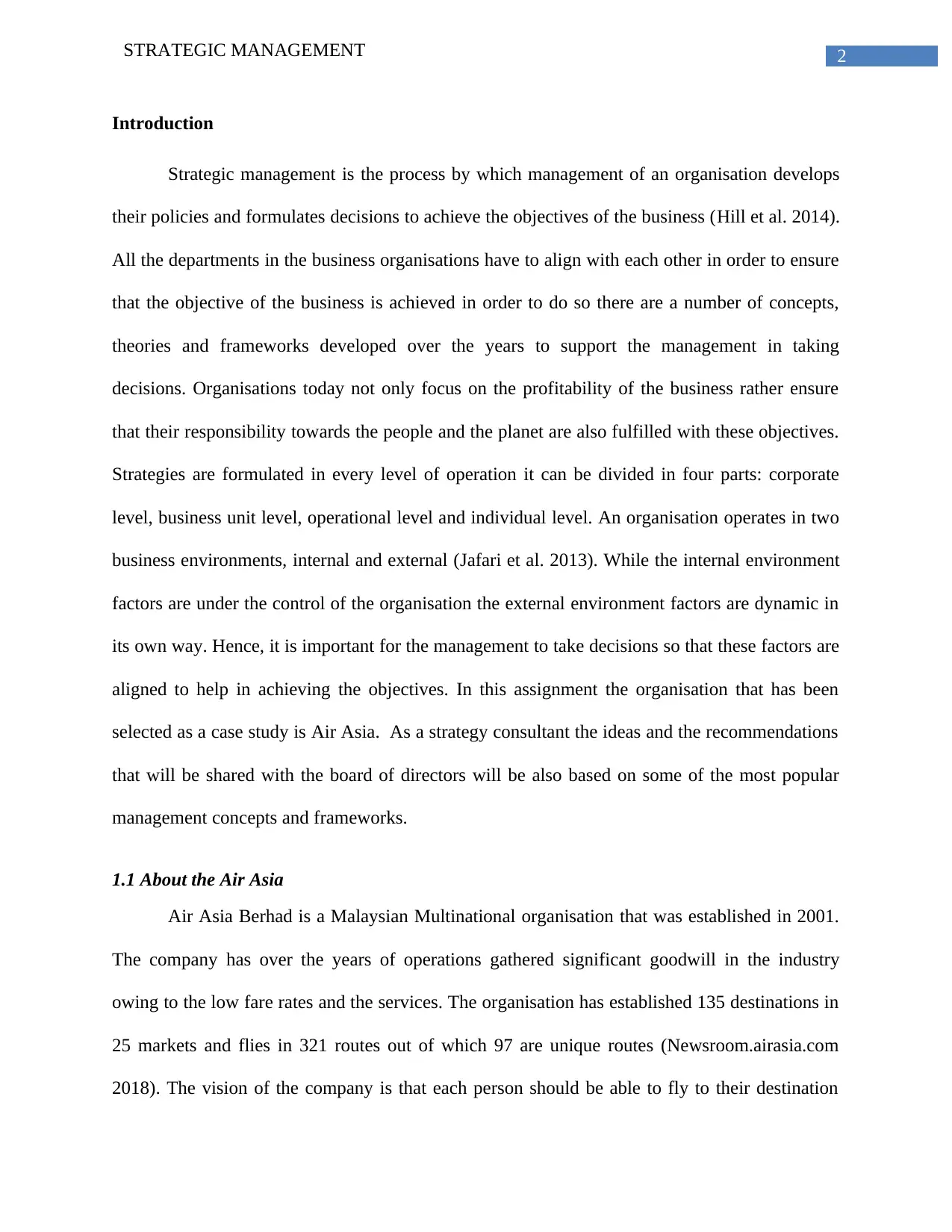
2STRATEGIC MANAGEMENT
Introduction
Strategic management is the process by which management of an organisation develops
their policies and formulates decisions to achieve the objectives of the business (Hill et al. 2014).
All the departments in the business organisations have to align with each other in order to ensure
that the objective of the business is achieved in order to do so there are a number of concepts,
theories and frameworks developed over the years to support the management in taking
decisions. Organisations today not only focus on the profitability of the business rather ensure
that their responsibility towards the people and the planet are also fulfilled with these objectives.
Strategies are formulated in every level of operation it can be divided in four parts: corporate
level, business unit level, operational level and individual level. An organisation operates in two
business environments, internal and external (Jafari et al. 2013). While the internal environment
factors are under the control of the organisation the external environment factors are dynamic in
its own way. Hence, it is important for the management to take decisions so that these factors are
aligned to help in achieving the objectives. In this assignment the organisation that has been
selected as a case study is Air Asia. As a strategy consultant the ideas and the recommendations
that will be shared with the board of directors will be also based on some of the most popular
management concepts and frameworks.
1.1 About the Air Asia
Air Asia Berhad is a Malaysian Multinational organisation that was established in 2001.
The company has over the years of operations gathered significant goodwill in the industry
owing to the low fare rates and the services. The organisation has established 135 destinations in
25 markets and flies in 321 routes out of which 97 are unique routes (Newsroom.airasia.com
2018). The vision of the company is that each person should be able to fly to their destination
Introduction
Strategic management is the process by which management of an organisation develops
their policies and formulates decisions to achieve the objectives of the business (Hill et al. 2014).
All the departments in the business organisations have to align with each other in order to ensure
that the objective of the business is achieved in order to do so there are a number of concepts,
theories and frameworks developed over the years to support the management in taking
decisions. Organisations today not only focus on the profitability of the business rather ensure
that their responsibility towards the people and the planet are also fulfilled with these objectives.
Strategies are formulated in every level of operation it can be divided in four parts: corporate
level, business unit level, operational level and individual level. An organisation operates in two
business environments, internal and external (Jafari et al. 2013). While the internal environment
factors are under the control of the organisation the external environment factors are dynamic in
its own way. Hence, it is important for the management to take decisions so that these factors are
aligned to help in achieving the objectives. In this assignment the organisation that has been
selected as a case study is Air Asia. As a strategy consultant the ideas and the recommendations
that will be shared with the board of directors will be also based on some of the most popular
management concepts and frameworks.
1.1 About the Air Asia
Air Asia Berhad is a Malaysian Multinational organisation that was established in 2001.
The company has over the years of operations gathered significant goodwill in the industry
owing to the low fare rates and the services. The organisation has established 135 destinations in
25 markets and flies in 321 routes out of which 97 are unique routes (Newsroom.airasia.com
2018). The vision of the company is that each person should be able to fly to their destination
⊘ This is a preview!⊘
Do you want full access?
Subscribe today to unlock all pages.

Trusted by 1+ million students worldwide
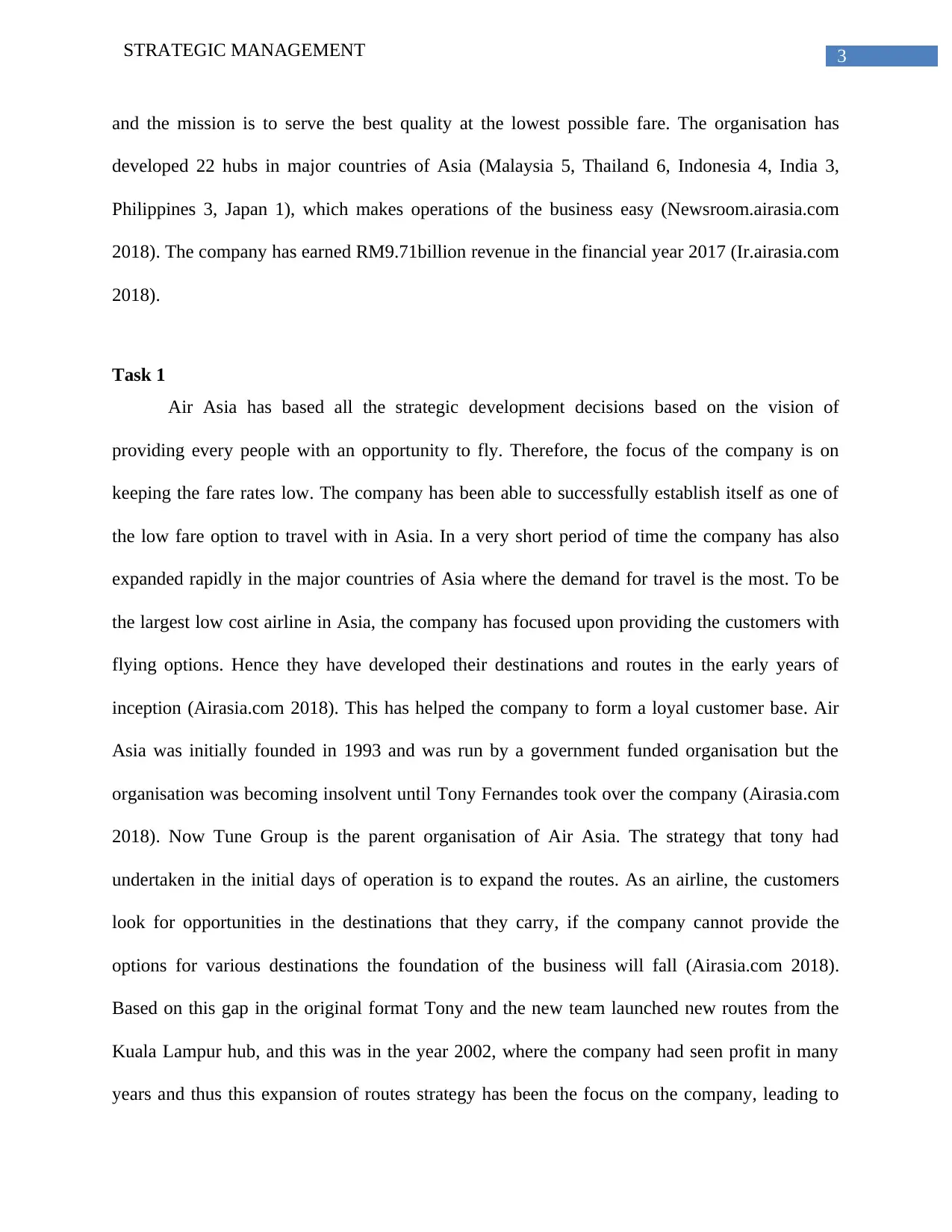
3STRATEGIC MANAGEMENT
and the mission is to serve the best quality at the lowest possible fare. The organisation has
developed 22 hubs in major countries of Asia (Malaysia 5, Thailand 6, Indonesia 4, India 3,
Philippines 3, Japan 1), which makes operations of the business easy (Newsroom.airasia.com
2018). The company has earned RM9.71billion revenue in the financial year 2017 (Ir.airasia.com
2018).
Task 1
Air Asia has based all the strategic development decisions based on the vision of
providing every people with an opportunity to fly. Therefore, the focus of the company is on
keeping the fare rates low. The company has been able to successfully establish itself as one of
the low fare option to travel with in Asia. In a very short period of time the company has also
expanded rapidly in the major countries of Asia where the demand for travel is the most. To be
the largest low cost airline in Asia, the company has focused upon providing the customers with
flying options. Hence they have developed their destinations and routes in the early years of
inception (Airasia.com 2018). This has helped the company to form a loyal customer base. Air
Asia was initially founded in 1993 and was run by a government funded organisation but the
organisation was becoming insolvent until Tony Fernandes took over the company (Airasia.com
2018). Now Tune Group is the parent organisation of Air Asia. The strategy that tony had
undertaken in the initial days of operation is to expand the routes. As an airline, the customers
look for opportunities in the destinations that they carry, if the company cannot provide the
options for various destinations the foundation of the business will fall (Airasia.com 2018).
Based on this gap in the original format Tony and the new team launched new routes from the
Kuala Lampur hub, and this was in the year 2002, where the company had seen profit in many
years and thus this expansion of routes strategy has been the focus on the company, leading to
and the mission is to serve the best quality at the lowest possible fare. The organisation has
developed 22 hubs in major countries of Asia (Malaysia 5, Thailand 6, Indonesia 4, India 3,
Philippines 3, Japan 1), which makes operations of the business easy (Newsroom.airasia.com
2018). The company has earned RM9.71billion revenue in the financial year 2017 (Ir.airasia.com
2018).
Task 1
Air Asia has based all the strategic development decisions based on the vision of
providing every people with an opportunity to fly. Therefore, the focus of the company is on
keeping the fare rates low. The company has been able to successfully establish itself as one of
the low fare option to travel with in Asia. In a very short period of time the company has also
expanded rapidly in the major countries of Asia where the demand for travel is the most. To be
the largest low cost airline in Asia, the company has focused upon providing the customers with
flying options. Hence they have developed their destinations and routes in the early years of
inception (Airasia.com 2018). This has helped the company to form a loyal customer base. Air
Asia was initially founded in 1993 and was run by a government funded organisation but the
organisation was becoming insolvent until Tony Fernandes took over the company (Airasia.com
2018). Now Tune Group is the parent organisation of Air Asia. The strategy that tony had
undertaken in the initial days of operation is to expand the routes. As an airline, the customers
look for opportunities in the destinations that they carry, if the company cannot provide the
options for various destinations the foundation of the business will fall (Airasia.com 2018).
Based on this gap in the original format Tony and the new team launched new routes from the
Kuala Lampur hub, and this was in the year 2002, where the company had seen profit in many
years and thus this expansion of routes strategy has been the focus on the company, leading to
Paraphrase This Document
Need a fresh take? Get an instant paraphrase of this document with our AI Paraphraser
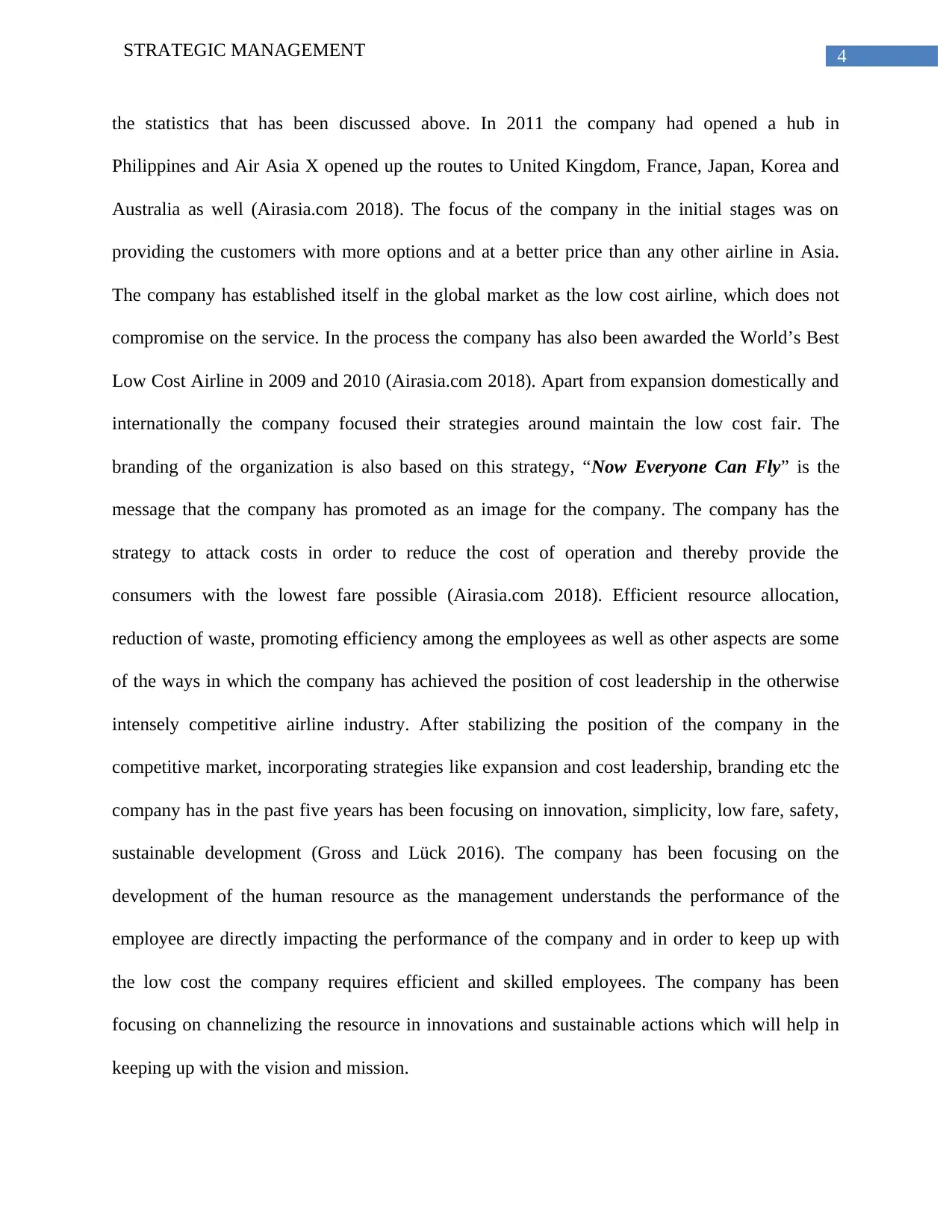
4STRATEGIC MANAGEMENT
the statistics that has been discussed above. In 2011 the company had opened a hub in
Philippines and Air Asia X opened up the routes to United Kingdom, France, Japan, Korea and
Australia as well (Airasia.com 2018). The focus of the company in the initial stages was on
providing the customers with more options and at a better price than any other airline in Asia.
The company has established itself in the global market as the low cost airline, which does not
compromise on the service. In the process the company has also been awarded the World’s Best
Low Cost Airline in 2009 and 2010 (Airasia.com 2018). Apart from expansion domestically and
internationally the company focused their strategies around maintain the low cost fair. The
branding of the organization is also based on this strategy, “Now Everyone Can Fly” is the
message that the company has promoted as an image for the company. The company has the
strategy to attack costs in order to reduce the cost of operation and thereby provide the
consumers with the lowest fare possible (Airasia.com 2018). Efficient resource allocation,
reduction of waste, promoting efficiency among the employees as well as other aspects are some
of the ways in which the company has achieved the position of cost leadership in the otherwise
intensely competitive airline industry. After stabilizing the position of the company in the
competitive market, incorporating strategies like expansion and cost leadership, branding etc the
company has in the past five years has been focusing on innovation, simplicity, low fare, safety,
sustainable development (Gross and Lück 2016). The company has been focusing on the
development of the human resource as the management understands the performance of the
employee are directly impacting the performance of the company and in order to keep up with
the low cost the company requires efficient and skilled employees. The company has been
focusing on channelizing the resource in innovations and sustainable actions which will help in
keeping up with the vision and mission.
the statistics that has been discussed above. In 2011 the company had opened a hub in
Philippines and Air Asia X opened up the routes to United Kingdom, France, Japan, Korea and
Australia as well (Airasia.com 2018). The focus of the company in the initial stages was on
providing the customers with more options and at a better price than any other airline in Asia.
The company has established itself in the global market as the low cost airline, which does not
compromise on the service. In the process the company has also been awarded the World’s Best
Low Cost Airline in 2009 and 2010 (Airasia.com 2018). Apart from expansion domestically and
internationally the company focused their strategies around maintain the low cost fair. The
branding of the organization is also based on this strategy, “Now Everyone Can Fly” is the
message that the company has promoted as an image for the company. The company has the
strategy to attack costs in order to reduce the cost of operation and thereby provide the
consumers with the lowest fare possible (Airasia.com 2018). Efficient resource allocation,
reduction of waste, promoting efficiency among the employees as well as other aspects are some
of the ways in which the company has achieved the position of cost leadership in the otherwise
intensely competitive airline industry. After stabilizing the position of the company in the
competitive market, incorporating strategies like expansion and cost leadership, branding etc the
company has in the past five years has been focusing on innovation, simplicity, low fare, safety,
sustainable development (Gross and Lück 2016). The company has been focusing on the
development of the human resource as the management understands the performance of the
employee are directly impacting the performance of the company and in order to keep up with
the low cost the company requires efficient and skilled employees. The company has been
focusing on channelizing the resource in innovations and sustainable actions which will help in
keeping up with the vision and mission.
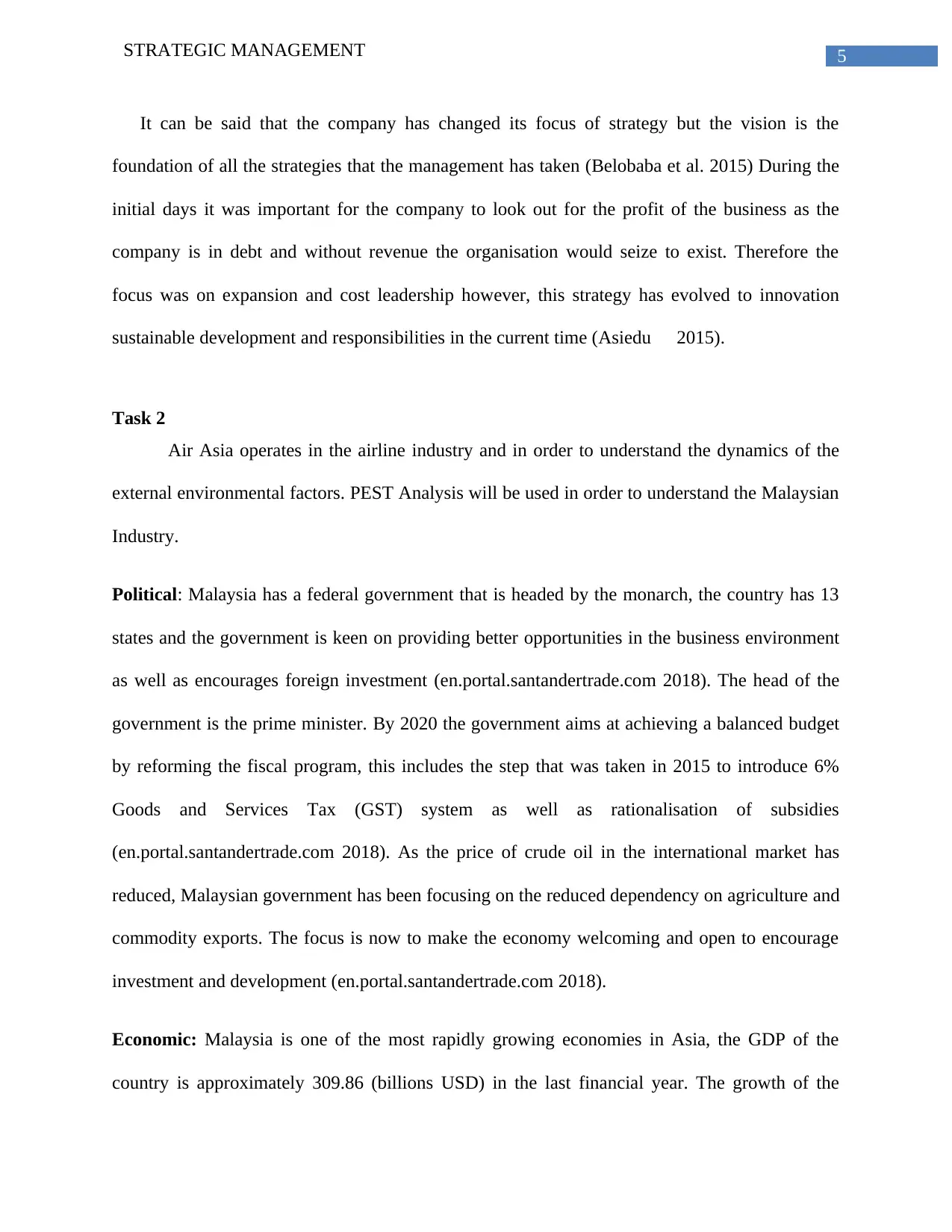
5STRATEGIC MANAGEMENT
It can be said that the company has changed its focus of strategy but the vision is the
foundation of all the strategies that the management has taken (Belobaba et al. 2015) During the
initial days it was important for the company to look out for the profit of the business as the
company is in debt and without revenue the organisation would seize to exist. Therefore the
focus was on expansion and cost leadership however, this strategy has evolved to innovation
sustainable development and responsibilities in the current time (Asiedu 2015).
Task 2
Air Asia operates in the airline industry and in order to understand the dynamics of the
external environmental factors. PEST Analysis will be used in order to understand the Malaysian
Industry.
Political: Malaysia has a federal government that is headed by the monarch, the country has 13
states and the government is keen on providing better opportunities in the business environment
as well as encourages foreign investment (en.portal.santandertrade.com 2018). The head of the
government is the prime minister. By 2020 the government aims at achieving a balanced budget
by reforming the fiscal program, this includes the step that was taken in 2015 to introduce 6%
Goods and Services Tax (GST) system as well as rationalisation of subsidies
(en.portal.santandertrade.com 2018). As the price of crude oil in the international market has
reduced, Malaysian government has been focusing on the reduced dependency on agriculture and
commodity exports. The focus is now to make the economy welcoming and open to encourage
investment and development (en.portal.santandertrade.com 2018).
Economic: Malaysia is one of the most rapidly growing economies in Asia, the GDP of the
country is approximately 309.86 (billions USD) in the last financial year. The growth of the
It can be said that the company has changed its focus of strategy but the vision is the
foundation of all the strategies that the management has taken (Belobaba et al. 2015) During the
initial days it was important for the company to look out for the profit of the business as the
company is in debt and without revenue the organisation would seize to exist. Therefore the
focus was on expansion and cost leadership however, this strategy has evolved to innovation
sustainable development and responsibilities in the current time (Asiedu 2015).
Task 2
Air Asia operates in the airline industry and in order to understand the dynamics of the
external environmental factors. PEST Analysis will be used in order to understand the Malaysian
Industry.
Political: Malaysia has a federal government that is headed by the monarch, the country has 13
states and the government is keen on providing better opportunities in the business environment
as well as encourages foreign investment (en.portal.santandertrade.com 2018). The head of the
government is the prime minister. By 2020 the government aims at achieving a balanced budget
by reforming the fiscal program, this includes the step that was taken in 2015 to introduce 6%
Goods and Services Tax (GST) system as well as rationalisation of subsidies
(en.portal.santandertrade.com 2018). As the price of crude oil in the international market has
reduced, Malaysian government has been focusing on the reduced dependency on agriculture and
commodity exports. The focus is now to make the economy welcoming and open to encourage
investment and development (en.portal.santandertrade.com 2018).
Economic: Malaysia is one of the most rapidly growing economies in Asia, the GDP of the
country is approximately 309.86 (billions USD) in the last financial year. The growth of the
⊘ This is a preview!⊘
Do you want full access?
Subscribe today to unlock all pages.

Trusted by 1+ million students worldwide
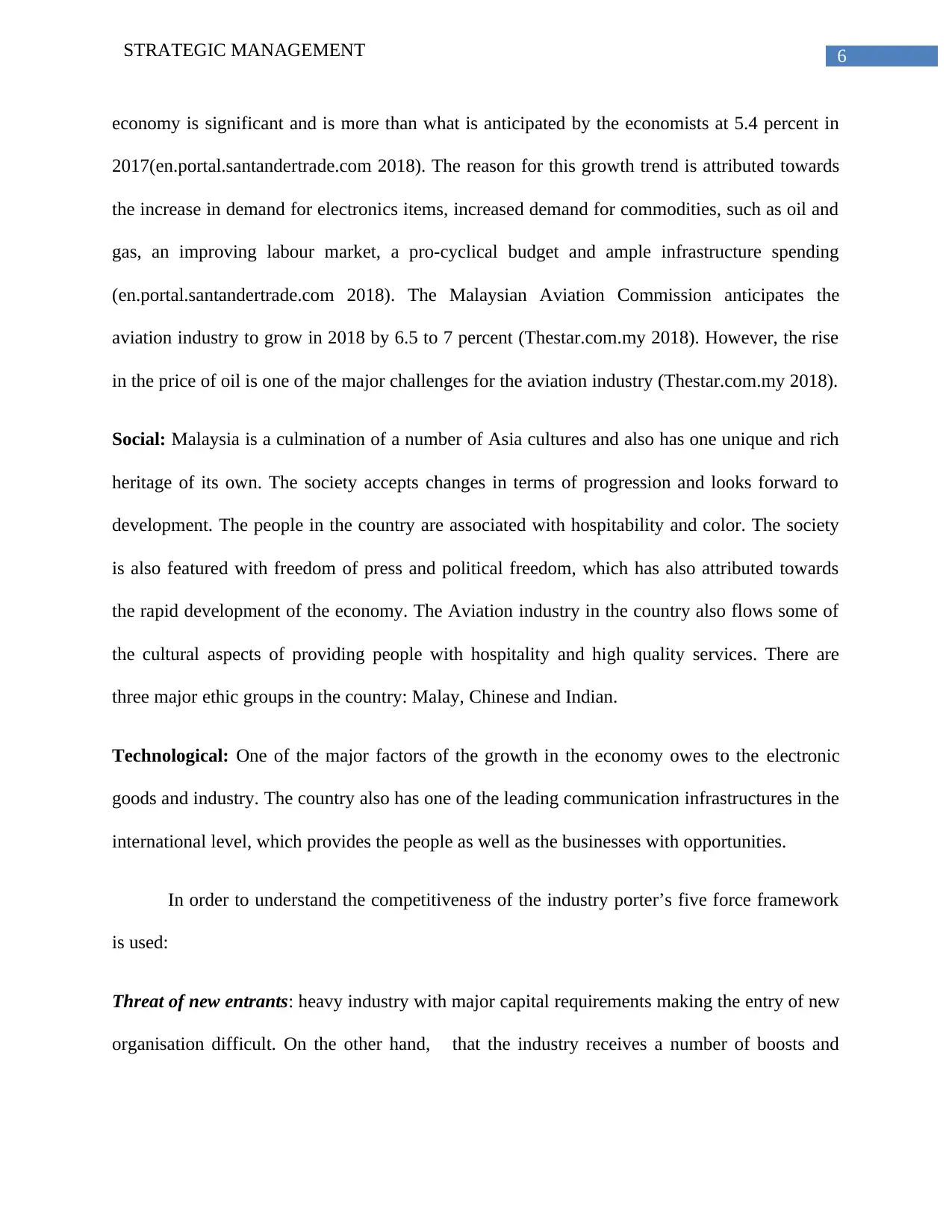
6STRATEGIC MANAGEMENT
economy is significant and is more than what is anticipated by the economists at 5.4 percent in
2017(en.portal.santandertrade.com 2018). The reason for this growth trend is attributed towards
the increase in demand for electronics items, increased demand for commodities, such as oil and
gas, an improving labour market, a pro-cyclical budget and ample infrastructure spending
(en.portal.santandertrade.com 2018). The Malaysian Aviation Commission anticipates the
aviation industry to grow in 2018 by 6.5 to 7 percent (Thestar.com.my 2018). However, the rise
in the price of oil is one of the major challenges for the aviation industry (Thestar.com.my 2018).
Social: Malaysia is a culmination of a number of Asia cultures and also has one unique and rich
heritage of its own. The society accepts changes in terms of progression and looks forward to
development. The people in the country are associated with hospitability and color. The society
is also featured with freedom of press and political freedom, which has also attributed towards
the rapid development of the economy. The Aviation industry in the country also flows some of
the cultural aspects of providing people with hospitality and high quality services. There are
three major ethic groups in the country: Malay, Chinese and Indian.
Technological: One of the major factors of the growth in the economy owes to the electronic
goods and industry. The country also has one of the leading communication infrastructures in the
international level, which provides the people as well as the businesses with opportunities.
In order to understand the competitiveness of the industry porter’s five force framework
is used:
Threat of new entrants: heavy industry with major capital requirements making the entry of new
organisation difficult. On the other hand, that the industry receives a number of boosts and
economy is significant and is more than what is anticipated by the economists at 5.4 percent in
2017(en.portal.santandertrade.com 2018). The reason for this growth trend is attributed towards
the increase in demand for electronics items, increased demand for commodities, such as oil and
gas, an improving labour market, a pro-cyclical budget and ample infrastructure spending
(en.portal.santandertrade.com 2018). The Malaysian Aviation Commission anticipates the
aviation industry to grow in 2018 by 6.5 to 7 percent (Thestar.com.my 2018). However, the rise
in the price of oil is one of the major challenges for the aviation industry (Thestar.com.my 2018).
Social: Malaysia is a culmination of a number of Asia cultures and also has one unique and rich
heritage of its own. The society accepts changes in terms of progression and looks forward to
development. The people in the country are associated with hospitability and color. The society
is also featured with freedom of press and political freedom, which has also attributed towards
the rapid development of the economy. The Aviation industry in the country also flows some of
the cultural aspects of providing people with hospitality and high quality services. There are
three major ethic groups in the country: Malay, Chinese and Indian.
Technological: One of the major factors of the growth in the economy owes to the electronic
goods and industry. The country also has one of the leading communication infrastructures in the
international level, which provides the people as well as the businesses with opportunities.
In order to understand the competitiveness of the industry porter’s five force framework
is used:
Threat of new entrants: heavy industry with major capital requirements making the entry of new
organisation difficult. On the other hand, that the industry receives a number of boosts and
Paraphrase This Document
Need a fresh take? Get an instant paraphrase of this document with our AI Paraphraser
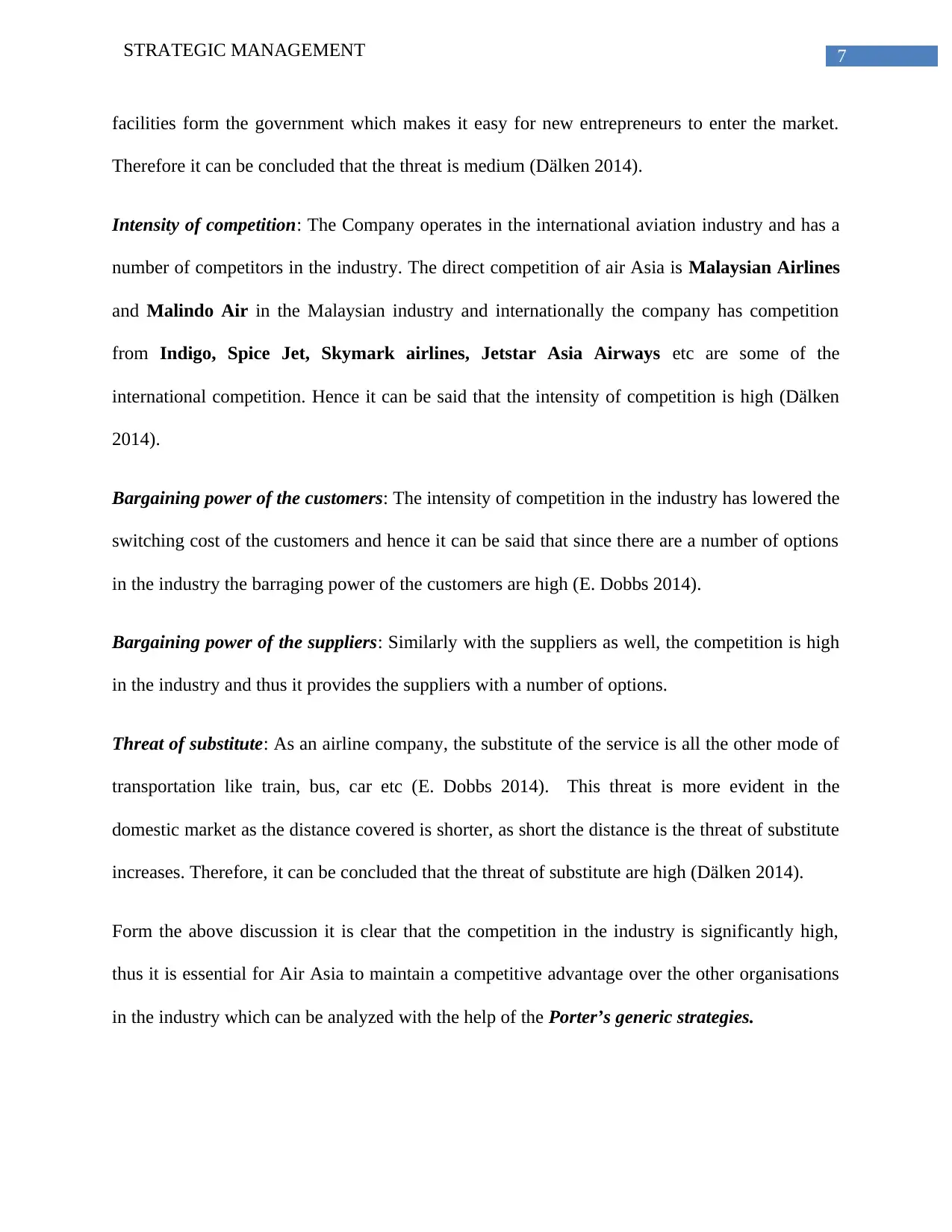
7STRATEGIC MANAGEMENT
facilities form the government which makes it easy for new entrepreneurs to enter the market.
Therefore it can be concluded that the threat is medium (Dälken 2014).
Intensity of competition: The Company operates in the international aviation industry and has a
number of competitors in the industry. The direct competition of air Asia is Malaysian Airlines
and Malindo Air in the Malaysian industry and internationally the company has competition
from Indigo, Spice Jet, Skymark airlines, Jetstar Asia Airways etc are some of the
international competition. Hence it can be said that the intensity of competition is high (Dälken
2014).
Bargaining power of the customers: The intensity of competition in the industry has lowered the
switching cost of the customers and hence it can be said that since there are a number of options
in the industry the barraging power of the customers are high (E. Dobbs 2014).
Bargaining power of the suppliers: Similarly with the suppliers as well, the competition is high
in the industry and thus it provides the suppliers with a number of options.
Threat of substitute: As an airline company, the substitute of the service is all the other mode of
transportation like train, bus, car etc (E. Dobbs 2014). This threat is more evident in the
domestic market as the distance covered is shorter, as short the distance is the threat of substitute
increases. Therefore, it can be concluded that the threat of substitute are high (Dälken 2014).
Form the above discussion it is clear that the competition in the industry is significantly high,
thus it is essential for Air Asia to maintain a competitive advantage over the other organisations
in the industry which can be analyzed with the help of the Porter’s generic strategies.
facilities form the government which makes it easy for new entrepreneurs to enter the market.
Therefore it can be concluded that the threat is medium (Dälken 2014).
Intensity of competition: The Company operates in the international aviation industry and has a
number of competitors in the industry. The direct competition of air Asia is Malaysian Airlines
and Malindo Air in the Malaysian industry and internationally the company has competition
from Indigo, Spice Jet, Skymark airlines, Jetstar Asia Airways etc are some of the
international competition. Hence it can be said that the intensity of competition is high (Dälken
2014).
Bargaining power of the customers: The intensity of competition in the industry has lowered the
switching cost of the customers and hence it can be said that since there are a number of options
in the industry the barraging power of the customers are high (E. Dobbs 2014).
Bargaining power of the suppliers: Similarly with the suppliers as well, the competition is high
in the industry and thus it provides the suppliers with a number of options.
Threat of substitute: As an airline company, the substitute of the service is all the other mode of
transportation like train, bus, car etc (E. Dobbs 2014). This threat is more evident in the
domestic market as the distance covered is shorter, as short the distance is the threat of substitute
increases. Therefore, it can be concluded that the threat of substitute are high (Dälken 2014).
Form the above discussion it is clear that the competition in the industry is significantly high,
thus it is essential for Air Asia to maintain a competitive advantage over the other organisations
in the industry which can be analyzed with the help of the Porter’s generic strategies.
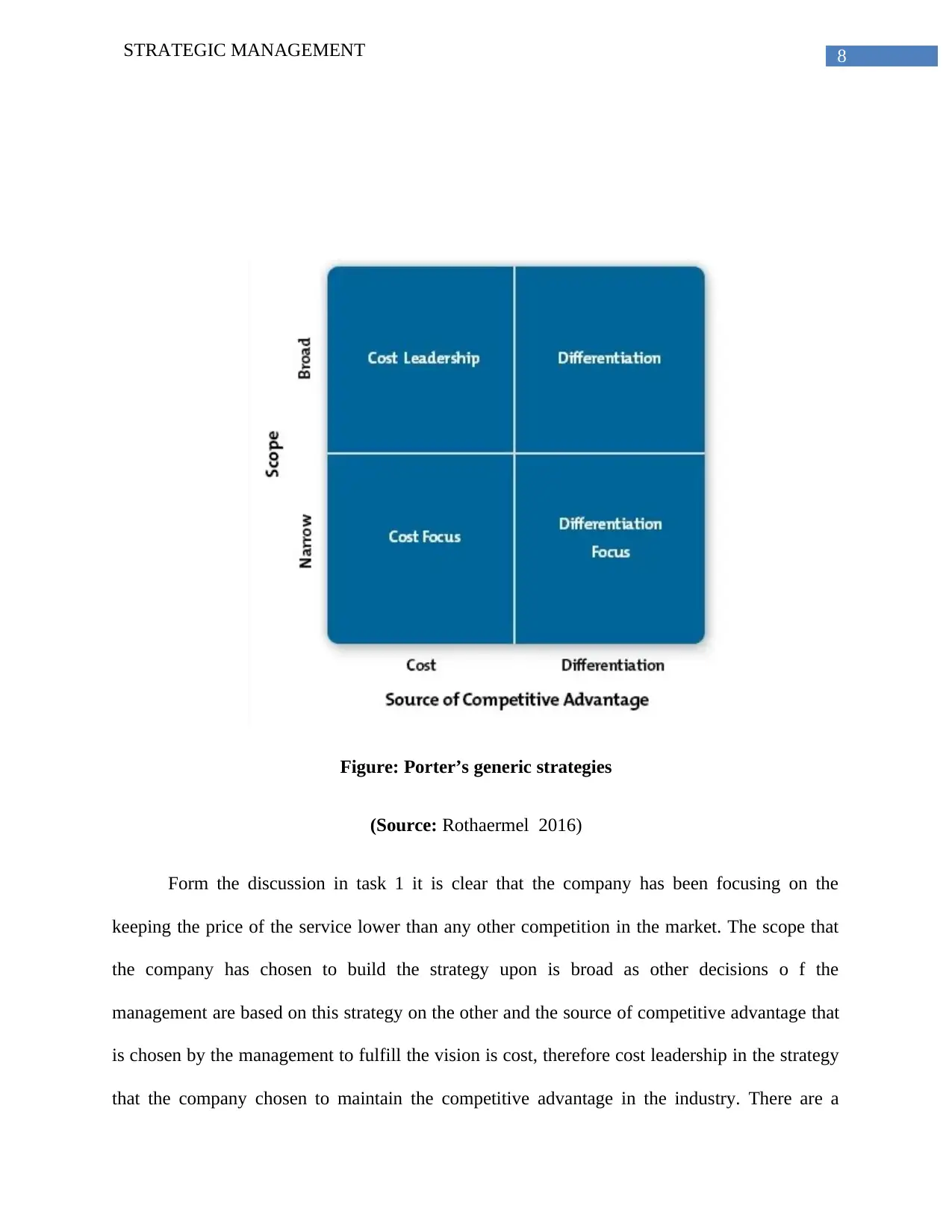
8STRATEGIC MANAGEMENT
Figure: Porter’s generic strategies
(Source: Rothaermel 2016)
Form the discussion in task 1 it is clear that the company has been focusing on the
keeping the price of the service lower than any other competition in the market. The scope that
the company has chosen to build the strategy upon is broad as other decisions o f the
management are based on this strategy on the other and the source of competitive advantage that
is chosen by the management to fulfill the vision is cost, therefore cost leadership in the strategy
that the company chosen to maintain the competitive advantage in the industry. There are a
Figure: Porter’s generic strategies
(Source: Rothaermel 2016)
Form the discussion in task 1 it is clear that the company has been focusing on the
keeping the price of the service lower than any other competition in the market. The scope that
the company has chosen to build the strategy upon is broad as other decisions o f the
management are based on this strategy on the other and the source of competitive advantage that
is chosen by the management to fulfill the vision is cost, therefore cost leadership in the strategy
that the company chosen to maintain the competitive advantage in the industry. There are a
⊘ This is a preview!⊘
Do you want full access?
Subscribe today to unlock all pages.

Trusted by 1+ million students worldwide
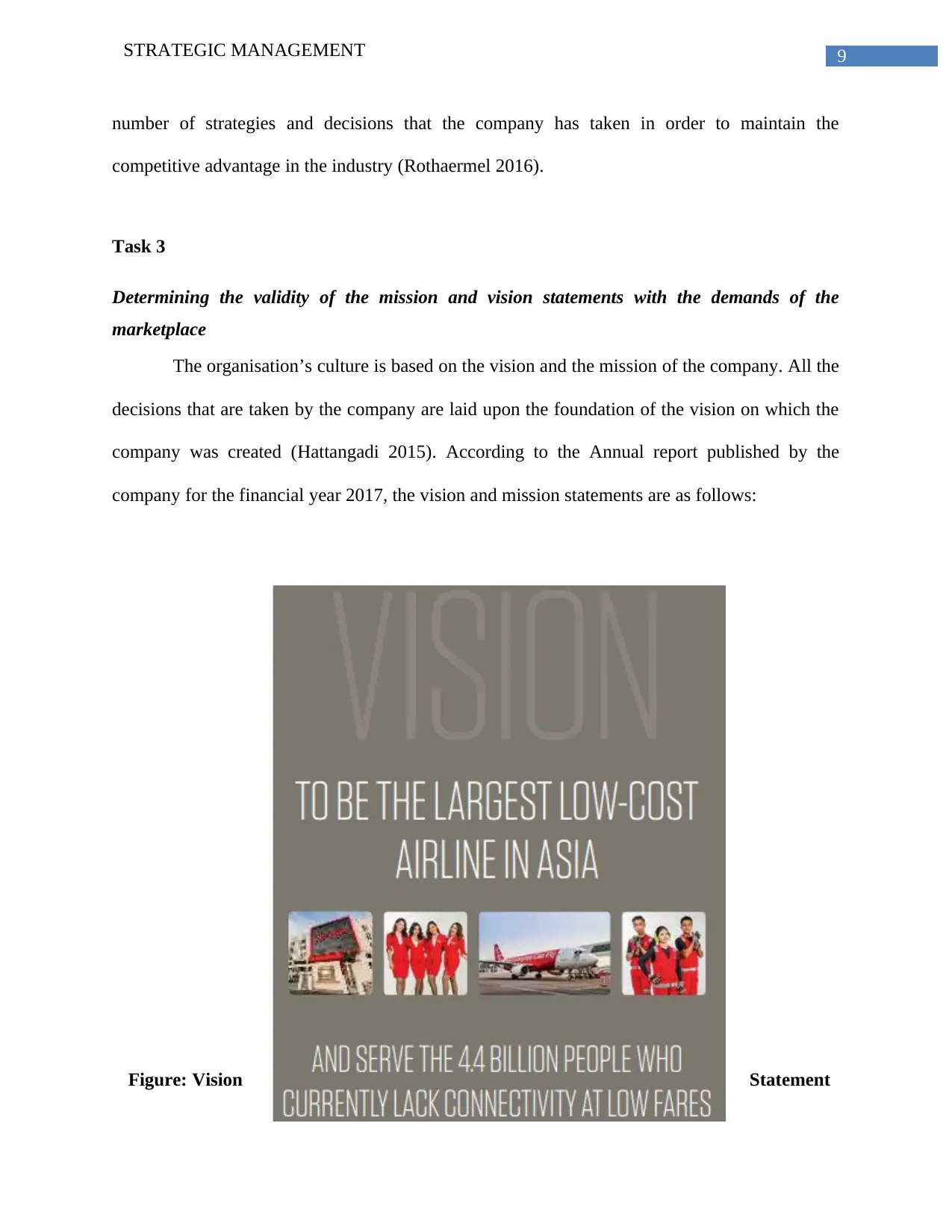
9STRATEGIC MANAGEMENT
number of strategies and decisions that the company has taken in order to maintain the
competitive advantage in the industry (Rothaermel 2016).
Task 3
Determining the validity of the mission and vision statements with the demands of the
marketplace
The organisation’s culture is based on the vision and the mission of the company. All the
decisions that are taken by the company are laid upon the foundation of the vision on which the
company was created (Hattangadi 2015). According to the Annual report published by the
company for the financial year 2017, the vision and mission statements are as follows:
Figure: Vision Statement
number of strategies and decisions that the company has taken in order to maintain the
competitive advantage in the industry (Rothaermel 2016).
Task 3
Determining the validity of the mission and vision statements with the demands of the
marketplace
The organisation’s culture is based on the vision and the mission of the company. All the
decisions that are taken by the company are laid upon the foundation of the vision on which the
company was created (Hattangadi 2015). According to the Annual report published by the
company for the financial year 2017, the vision and mission statements are as follows:
Figure: Vision Statement
Paraphrase This Document
Need a fresh take? Get an instant paraphrase of this document with our AI Paraphraser
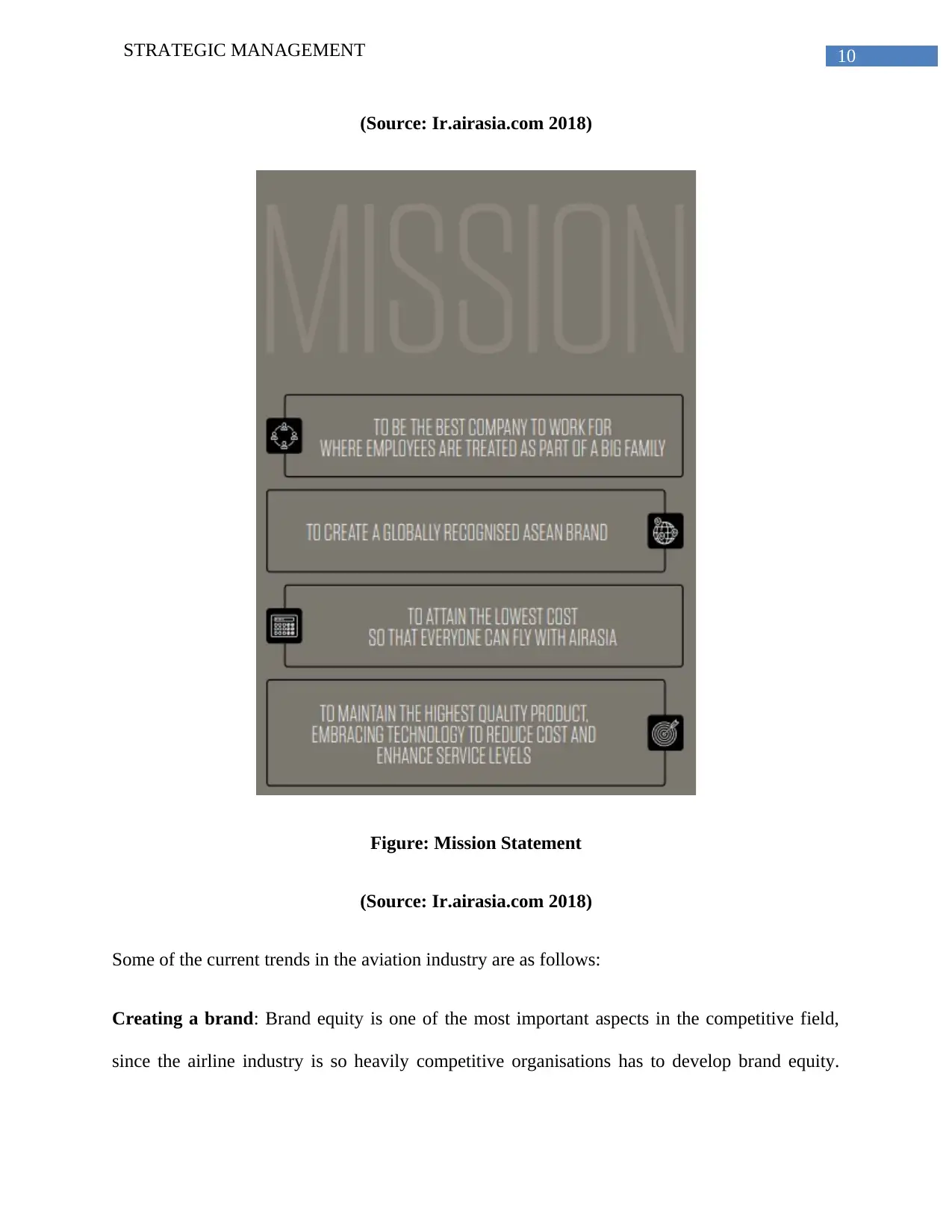
10STRATEGIC MANAGEMENT
(Source: Ir.airasia.com 2018)
Figure: Mission Statement
(Source: Ir.airasia.com 2018)
Some of the current trends in the aviation industry are as follows:
Creating a brand: Brand equity is one of the most important aspects in the competitive field,
since the airline industry is so heavily competitive organisations has to develop brand equity.
(Source: Ir.airasia.com 2018)
Figure: Mission Statement
(Source: Ir.airasia.com 2018)
Some of the current trends in the aviation industry are as follows:
Creating a brand: Brand equity is one of the most important aspects in the competitive field,
since the airline industry is so heavily competitive organisations has to develop brand equity.
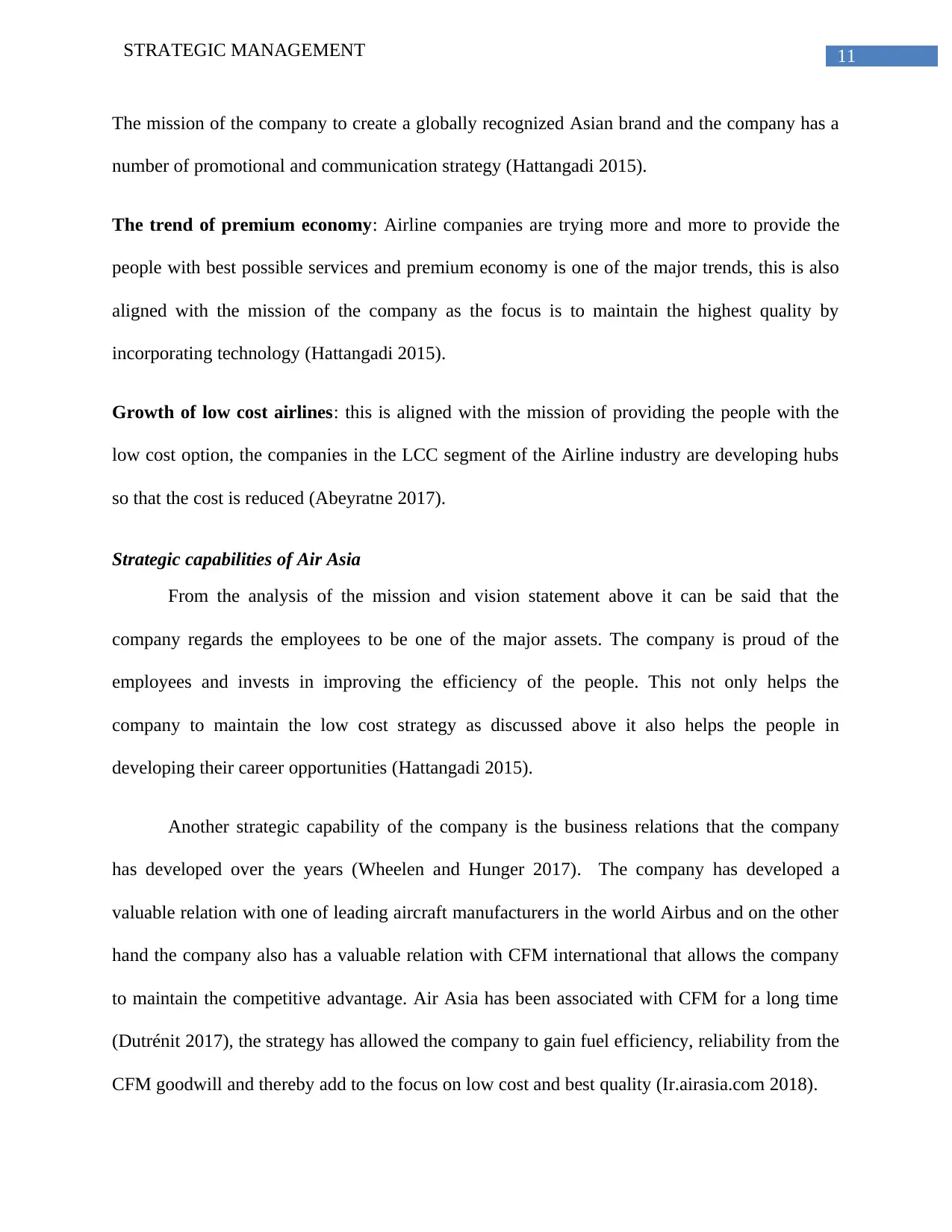
11STRATEGIC MANAGEMENT
The mission of the company to create a globally recognized Asian brand and the company has a
number of promotional and communication strategy (Hattangadi 2015).
The trend of premium economy: Airline companies are trying more and more to provide the
people with best possible services and premium economy is one of the major trends, this is also
aligned with the mission of the company as the focus is to maintain the highest quality by
incorporating technology (Hattangadi 2015).
Growth of low cost airlines: this is aligned with the mission of providing the people with the
low cost option, the companies in the LCC segment of the Airline industry are developing hubs
so that the cost is reduced (Abeyratne 2017).
Strategic capabilities of Air Asia
From the analysis of the mission and vision statement above it can be said that the
company regards the employees to be one of the major assets. The company is proud of the
employees and invests in improving the efficiency of the people. This not only helps the
company to maintain the low cost strategy as discussed above it also helps the people in
developing their career opportunities (Hattangadi 2015).
Another strategic capability of the company is the business relations that the company
has developed over the years (Wheelen and Hunger 2017). The company has developed a
valuable relation with one of leading aircraft manufacturers in the world Airbus and on the other
hand the company also has a valuable relation with CFM international that allows the company
to maintain the competitive advantage. Air Asia has been associated with CFM for a long time
(Dutrénit 2017), the strategy has allowed the company to gain fuel efficiency, reliability from the
CFM goodwill and thereby add to the focus on low cost and best quality (Ir.airasia.com 2018).
The mission of the company to create a globally recognized Asian brand and the company has a
number of promotional and communication strategy (Hattangadi 2015).
The trend of premium economy: Airline companies are trying more and more to provide the
people with best possible services and premium economy is one of the major trends, this is also
aligned with the mission of the company as the focus is to maintain the highest quality by
incorporating technology (Hattangadi 2015).
Growth of low cost airlines: this is aligned with the mission of providing the people with the
low cost option, the companies in the LCC segment of the Airline industry are developing hubs
so that the cost is reduced (Abeyratne 2017).
Strategic capabilities of Air Asia
From the analysis of the mission and vision statement above it can be said that the
company regards the employees to be one of the major assets. The company is proud of the
employees and invests in improving the efficiency of the people. This not only helps the
company to maintain the low cost strategy as discussed above it also helps the people in
developing their career opportunities (Hattangadi 2015).
Another strategic capability of the company is the business relations that the company
has developed over the years (Wheelen and Hunger 2017). The company has developed a
valuable relation with one of leading aircraft manufacturers in the world Airbus and on the other
hand the company also has a valuable relation with CFM international that allows the company
to maintain the competitive advantage. Air Asia has been associated with CFM for a long time
(Dutrénit 2017), the strategy has allowed the company to gain fuel efficiency, reliability from the
CFM goodwill and thereby add to the focus on low cost and best quality (Ir.airasia.com 2018).
⊘ This is a preview!⊘
Do you want full access?
Subscribe today to unlock all pages.

Trusted by 1+ million students worldwide
1 out of 20
Related Documents
Your All-in-One AI-Powered Toolkit for Academic Success.
+13062052269
info@desklib.com
Available 24*7 on WhatsApp / Email
![[object Object]](/_next/static/media/star-bottom.7253800d.svg)
Unlock your academic potential
Copyright © 2020–2025 A2Z Services. All Rights Reserved. Developed and managed by ZUCOL.




